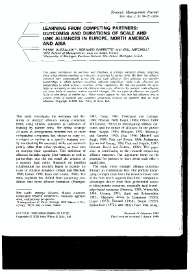Learning from competing partners : outcomes and durations of scale and link alliances in Europe, North America and Asia

Contenido multimedia no disponible por derechos de autor o por acceso restringido. Contacte con la institución para más información.
| Tag | 1 | 2 | Valor |
|---|---|---|---|
| LDR | 00000nab a2200000 i 4500 | ||
| 001 | MAP20071501169 | ||
| 003 | MAP | ||
| 005 | 20080418122659.0 | ||
| 007 | hzruuu---uuuu | ||
| 008 | 001011e20000201gbr|||| | |00010|eng d | ||
| 040 | $aMAP$bspa | ||
| 084 | $a922.111 | ||
| 100 | 1 | $0MAPA20080161156$aDussauge, Pierre | |
| 245 | 1 | 0 | $aLearning from competing partners$b: outcomes and durations of scale and link alliances in Europe, North America and Asia$cPierre Dussauge, Bernard Garrette and Will Mitchell |
| 520 | 8 | $aThis paper investigates the outcomes and durations of strategic alliances among competing firms, using alliance outcomes as indicators of learning by partner firms. We show that alliance outcomes vary sistematically accross link and scale alliances. Link alliances are interfirm partnerships to which partners contribute different capabilities, while scale alliances are partnerships to which partners contribute similar capabilities. We find that partners are more likely to reorganize or take over link alliances than scale alliances. By contrast, scale alliances are more likely to continue without material changes. The two types of alliances are equally likely to shut down, at similar ages. These results support the view that link alliances lead to greater levels of learning and capability acquisition between the partners than do scale alliances | |
| 650 | 1 | 1 | $0MAPA20080628895$aAprendizaje de las organizaciones |
| 650 | 1 | 1 | $0MAPA20080599881$aAlianzas estratégicas |
| 650 | 1 | 1 | $0MAPA20080557591$aCompetencia |
| 650 | 1 | 1 | $0MAPA20080597665$aMétodos estadísticos |
| 700 | 1 | $0MAPA20080192433$aGarrette, Bernard | |
| 700 | 1 | $0MAPA20080108960$aMitchell, Will | |
| 773 | 0 | $wMAP20077100307$tStrategic management journal$dChichester [etc.] : Wiley$gVol. 21, nº 2, February 2000 ; p. 99-126 |

